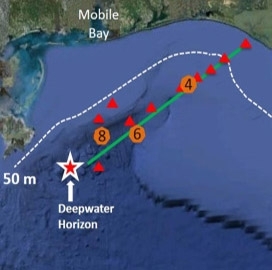
A simulation analysis of the plankton fate of the Deepwater Horizon oil spills
A two-dimensional (2-D) ecosystem model, set within the De Soto Canyon ecotone of the Northern Gulf of Mexico (NGOM) and driven by 3-D flow fields from decoupled water and air circulation models, explores the daily food web and sedimentary consequences, as well as potential public health implications, of oil-, nutrient-, and overfishing-induced transitions of dominant particle transports to the sea floor: from changing vectors of copepod fecal pellets to those of marine snow over the annual period of 2010–2011. Recent spilled petrochemicals are found to minimally impact already decimated zooplankton populations on the West Florida shelf (WFS). They facilitate instead formation of marine snow macroaggregates. These recent oil effects just exacerbate other results of prior overfishing in the absence of major eutrophication along the eastern side of this ecotone. East of the De Soto Canyon ecotone, overly optimistic removals of piscivore fish stocks over the last half-century had already caused a trophic cascade, with ~95% of WFS marine pelagic herbivore losses occurring by 2010, before the Deepwater Horizon [DWH] blowout. By contrast, west of De Soto Canyon, zooplankton on the eutrophic Louisiana shelf were less impacted by overfishing, retaining order of magnitude more stocks of the same genera of copepods. Yet, during descent of modeled marine snow to the ~1200-m isobath of the upper slope, ~98% of the particulate import to the benthos is now mainly clay minerals of Mississippi River origin along the ecotone. The lithogenic particles are scavenged by aggregates from the whole water column, not only biotic plankton from just the near-surface euphotic zone. The model results here replicate concurrent time series of: 1) annual sediment accumulations, measured at the sea floor; 2) bimonthly onshore nutrient supplies, due to upwelling, forced remotely by the Loop Current; and 3) near-surface weekly phytoplankton changes, seen by satellite. Because of such minimal grazing stresses, after the most recent DWH oil reductions to ~50% of the remaining few WFS copepods, their decreased herbivory amounts to only an 8% fecal pellet contribution to the model’s particle fluxes, with 92% settling as marine snow to the sea bottom of the continental slope in 2010–2011 By contrast, 12% of the biotic particle exports, entrained within marine snow, result from increased loadings of Mississippi River nutrients via opened flood gates, while 50% of the ungrazed sinking phytoplankton are fueled by decadal anomalies of increased nutrient supplies from greater upwelling by the Loop Current. Finally, of the exiting phytodetritus embedded within marine snow from the 2010–2011 water columns, 38% are due to uptake of autocthonous nutrients in the slope waters. But, explicit upward fluxes of nutrient-poor, petrochemical dissolved organic carbon [DOC] substrates for use by aphotic chemolithoautotrophic bacterial bioremediators, responding to DWH oil releases and external dissolved nutrients, are now ignored in the present model. These model results also relate downstream, wind-borne trajectories of evaded potential marine aerosolized toxins to both human asthma episodes and total mercury amounts in coastal soils, without explicit sea-air exchanges of initial aerosols. Thus, future simulation analyses, with instead extant numerical descriptions of breaking wave exports of oil, harmful algal bloom [HAB], and Hg aerosol poisons, must fully couple onshore 3-D aerial imports of this suite of marine toxins to direct causal factors of adjacent human health impacts, constrained by known surrogate asthma hospitalization rates. They must next deconvolve net multiyear oil and top-down NGOM indirect losses of herbivores, within now unbalanced marine food webs of an overfishing-induced trophic cascade, from other concurrent anthropogenic forcings, due to in situ mercury, pesticide, and radionuclide poisonings, within linked habitats of both water and air, subject to continued climate and biotic changes of the southeastern U.S. seaboard.
The full article is available at the link below:
http://www.sciencedirect.com/science/article/pii/S0278434315300042
Walsh, J. J., Lenes, J. M., Darrow, B. P., Parks, A. A., Weisberg, R. H., Zheng, L., et al. (2015). A simulation analysis of the plankton fate of the Deepwater Horizon oil spills. Continental Shelf Research, 107, 50–68.


